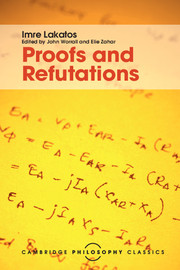Book contents
Appendix 1 - Another case-study in the method of proofs and refutations
Published online by Cambridge University Press: 05 November 2015
Summary
Cauchy's defence of the ‘principle of continuity’
The method of proofs and refutations is a very general heuristic pattern of mathematical discovery. However, it seems that it was discovered only in the 1840s and even today seems paradoxical to many people; and certainly it is nowhere properly acknowledged. In this appendix I shall try to sketch the story of a proof-analysis in mathematical analysis and to trace the sources of resistance to the understanding and recognition of it. I first repeat the skeleton of the method of proofs and refutations, a method which I have already illustrated by my case-study of the Cauchy proof of the Descartes–Euler conjecture.
There is a simple pattern of mathematical discovery– or of the growth of informal mathematical theories. It consists of the following stages:
(1) Primitive conjecture.
(2) Proof (a rough thought-experiment or argument, decomposing the primitive conjecture into subconjectures or lemmas).
(3) ‘GlobaL’ counterexamples (counterexamples to the primitive conjecture) emerge.
(4) Proof re-examined: the ‘guilty lemma’ to which the global counterexample is a ‘locaL’ counterexample is spotted. This guilty lemma may have previously remained ‘hidden’ or may have been misidentified. Now it is made explicit, and built into the primitive conjecture as a condition. The theorem – the improved conjecture – supersedes the primitive conjecture with the new proof-generated concept as its paramount new feature.
These four stages constitute the essential kernel of proof-analysis. But there are some further standard stages which frequently occur:
(5) Proofs of other theorems are examined to see if the newly found lemma or the new proof-generated concept occurs in them: this concept may be found lying at cross-roads of different proofs, and thus emerge as of basic importance.
(6) The hitherto accepted consequences of the original and now refuted conjecture are checked.
(7) Counterexamples are turned into new examples – new fields of inquiry open up.
I should now like to consider another case-study. Here the primitive conjecture is that the limit of any convergent series of continuous functions is itself continuous.
- Type
- Chapter
- Information
- Proofs and RefutationsThe Logic of Mathematical Discovery, pp. 135 - 150Publisher: Cambridge University PressPrint publication year: 2015



